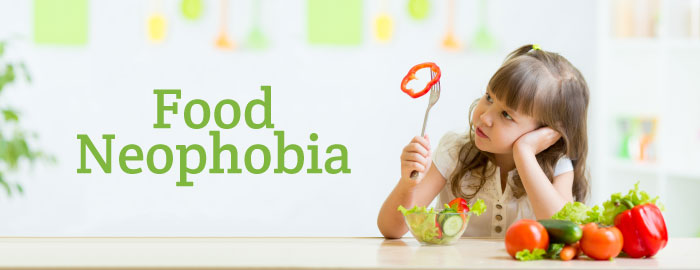Food Neophobia
When you ask children about their favourite food, most of them prefer eating sweet and energy-dense foods (cakes, ice cream, chocolate, French fries etc.) compared to other foods with bitter or strong taste, or low-energy-dense foods (like vegetables, cheese, fish, spices)
From 2 to around 10 years of age, humans are usually afraid of tasting new foods, and can hence reject some of them. We call this food neophobia. This fear is normal and universal and found even in animals. From an evolutionary perspective, food neophobia protects animals and humans against potential intoxications. As a result, when unknown food is on their plate, children usually select, inspect and refuse to eat it. Sometimes they may even spit out the new food after tasting it.
 Some other factors influence the eating behaviour of children, like their culture, genetics and their environment. However, even though humans reluctantly accept new foods, they are omnivorous and can access a large variety of foods. Mitigating food neophobia is therefore key for children to benefit from such diversity. Broadening food choices via focusing on sensory food education and eating pleasure helps optimize energy and nutritional requirements during development. In the long term, it enhances healthy child development, with a positive relationship with food.
Some other factors influence the eating behaviour of children, like their culture, genetics and their environment. However, even though humans reluctantly accept new foods, they are omnivorous and can access a large variety of foods. Mitigating food neophobia is therefore key for children to benefit from such diversity. Broadening food choices via focusing on sensory food education and eating pleasure helps optimize energy and nutritional requirements during development. In the long term, it enhances healthy child development, with a positive relationship with food.


Before the meal:
- Show and explain to children the new food while doing your groceries or during their preparation, so that they become familiar with it.
During the meal:
- Create a positive and friendly meal environment, with a joyful atmosphere. Also, avoid sensitive topics such as critiquing about your child’s grades in school, or discussing any disturbing subject.
- Avoid distractions or disturbances during meals (TV, smartphone, toys, books, noise).
- Taste the new food before the child or with him or her, so that they can imitate you
- Propose the new food, prepared in the same cooking process, several times. After at least 8 to 10 repeated exposures, the child will eventually accept eating and like it. Don’t give up after 2 trials.
- Respect your child’s internal physiological signal of hunger and satiety, instead of habituating them to external signals (finish the whole plate)
After the meal:
- If you give a reward for completing the new food item, preferably choose a non-food reward so your child doesn’t get habituated to this behaviour.
|



